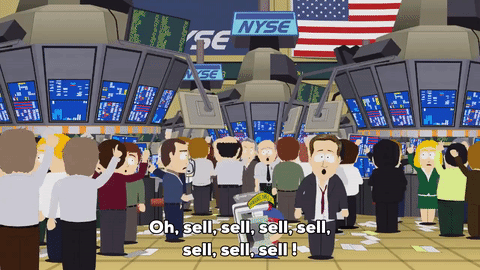Let me tell you about the quiet revolution happening in American finance
And All Stan Wanted to do Was Return a Margarita Maker...
I was doing my favorite thing - watching South Park - and saw one of my favorite episodes, the one where Stan tries to return Randy’s margarita maker and runs into the intricacies of securitization.
Quick Summary: Stan visits the store to return the machine, where he realizes his dad had obtained the machine on a payment plan from the manufacturer. He then visits the manufacturer to get his money back, who tells him they securitized all the payment plans into a pool and sold it to Wall Street. He then visits Wall Street (margarita maker in hand) to return it to the folks who own the security, only to learn that the federal government has purchased the security (this episode aired in 2008, when the government was routinely buying securitized assets, primarily mortgage-backed securities). This is a good summary of securitization for beginners.
It is worth watching this episode to understand the basics, including the part where the government randomly assigns values to assets (a lot of which occurred during the 2008 financial crisis).
The episode inspired me to write a Substack about securitization and my views on how AI will impact this massive industry. I hope you enjoy it! If you do, please subscribe - as this motivates me to share more.
Let me tell you about the quiet revolution happening in American finance
You know what I love about this country? We tackle complex problems and find solutions. Not with committees and hand-wringing, but with ingenuity and determination. A revolution is currently underway in the financial markets, largely unnoticed by many Americans, that will significantly alter the way credit flows through our economy.
We're talking about artificial intelligence transforming securitization - and before your eyes glaze over at the financial jargon, let me explain why this matters to every family trying to buy a home, every kid trying to finance a college education, and every entrepreneur trying to start a business.
The eleven trillion dollar engine nobody understands
Securitization. It's a ten-dollar word for a simple idea that keeps our economy humming. Here’s how it works:
Banks make loans - your mortgage, your car loan, your daughter's student loan.
But here's the thing: if banks had to keep every loan on their books, they'd run out of money to lend pretty quickly. So what do they do?
They bundle these loans together and sell them to investors. Brilliant, really. The bank receives fresh capital to make new loans, investors earn steady returns, and Americans gain access to credit.
We're not talking about pocket change here. This market - it's eleven trillion dollars. That's trillion with a T. Mortgage-backed securities alone? Eleven trillion outstanding. Every year, we're creating three hundred billion dollars in new securities. The CLO market, that's collateralized loan obligations for those keeping score at home, just hit $202 billion in new issuance.
By 2029, the global market is expected to reach $3.36 trillion.
Would you like to know why this matters? Because without securitization, that young couple in Olympia wouldn't qualify for a mortgage. That small business owner in Lynden couldn't expand her shop.
This isn't Wall Street abstraction - this is the lifeblood of American opportunity.
The magnificent inefficiency of the status quo
Now, here's where it gets interesting. The current system? It's as if we're still using rotary phones, while the rest of the world has moved to smartphones. Due diligence on a complex transaction typically takes between 60 and 120 days. Sixty to eighty percent of that is people manually reviewing documents. One in four data packages has errors. Rating agencies require a minimum of ninety days to issue a provisional rating.
And we can debate the quality of the ratings. Analysts can’t review every asset in a securitized bundle.
The costs are staggering. Half a million dollars for due diligence on a significant transaction. Total fees reach three percent of the deal value. In any other industry, we'd call this what it is - an antiquated system begging for innovation.
But here's the beautiful part - we're not just identifying problems, we're solving them. With artificial intelligence. And not the science fiction kind - the real, practical, change-your-life kind.
The supply side revolution (or how we're teaching computers to think like bankers, only better)
Let me tell you about Pagaya Technologies. Since 2018, they've facilitated twenty-nine billion dollars in AI-driven securitizations. Twenty-nine billion! Their machines can spot patterns that humans miss, such as how construction workers and healthcare workers with identical credit scores have vastly different employment volatility. They executed the first fully automated deal.
No human intervention. Zero.
MSCI developed neural networks that predict mortgage prepayments with seventy percent better accuracy than traditional models. Seventy percent! They can even capture "media effects" - how news coverage influences when people refinance. Cape Analytics uses satellites to assess property conditions across 110 million structures. Clear Capital's AURA system uses photo AI for automated appraisals.
This isn't replacing human judgment - it's augmenting it. It's giving us tools to make better, faster, and fairer decisions.
The demand side transformation (or why institutional investors are embracing their inner geek)
BlackRock's Aladdin platform manages $21.6 trillion in assets using machine learning. That's more than the GDP of the United States. They're running Monte Carlo simulations, unified modeling frameworks, and comprehensive risk assessments—all powered by AI.
Electronic trading now accounts for thirty-eight percent of investment-grade corporate bond trading. Tradeweb processes $55.4 trillion in monthly volume. Trillion! In a month! Their AI algorithms offer real-time pricing, liquidity, and market-making capabilities, transforming the way these securities are traded.
Forty-five percent of S&P 500 companies mentioned AI in their latest earnings calls. This isn't a fad - it's a fundamental shift in how finance operates.
The technology that makes it all possible (a love letter to American innovation)
We're using random forests, gradient boosting, neural networks - beautiful mathematical constructs that can find patterns in chaos. Natural language processing that reads documents with 95% accuracy, reducing processing time by 90%. Computer vision that values properties within two percent of the selling price. Reinforcement learning algorithms that consistently outperform human portfolio managers.
Real results? Lendbuzz closed a $219 million securitization with first-time AAA ratings by using AI to assess creditworthiness through alternative data. Wells Fargo cut fraud by sixty percent in one year. Capital One presented seven papers at NeurIPS on the applications of deep learning.
This is American innovation at its finest.
The promise and the peril (because with great power...)
The benefits are undeniable. Four hundred forty-seven billion dollars in projected cost savings across the industry. Processing that took weeks now takes hours. Fraud detection that actually works. Risk assessment that sees around corners.
However, and this is crucial, we must be honest about the risks. These AI models can be opaque, functioning as black boxes. We don't always understand how they reach their conclusions. They can perpetuate historical biases if we're not careful. They're vulnerable to cyberattacks. Market concentration around a few AI providers could create systemic risks. And yes, some traditional jobs will disappear - though history shows technology creates more jobs than it destroys.
Keep reading with a 7-day free trial
Subscribe to Wired for Scale: Sid Rao's Musings to keep reading this post and get 7 days of free access to the full post archives.






